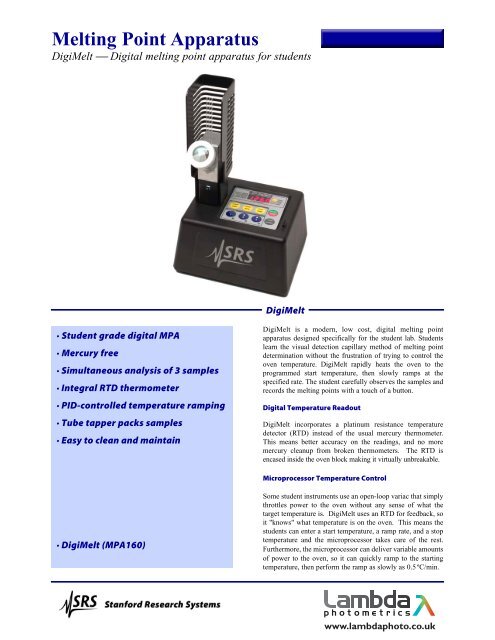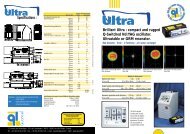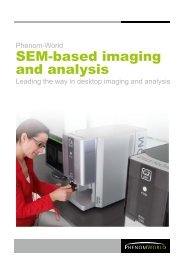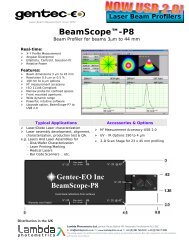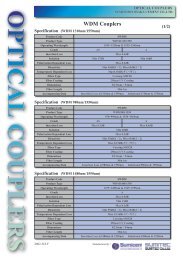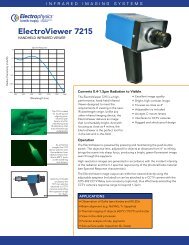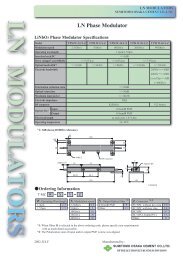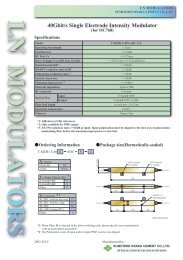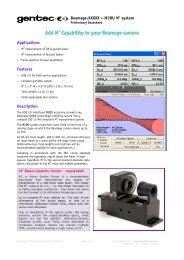Melting Point Apparatus - Lambda Photometrics
Melting Point Apparatus - Lambda Photometrics
Melting Point Apparatus - Lambda Photometrics
Create successful ePaper yourself
Turn your PDF publications into a flip-book with our unique Google optimized e-Paper software.
<strong>Melting</strong> <strong>Point</strong> <strong>Apparatus</strong><br />
DigiMelt ⎯ Digital melting point apparatus for students<br />
DigiMelt<br />
· Student grade digital MPA<br />
· Mercury free<br />
· Simultaneous analysis of 3 samples<br />
· Integral RTD thermometer<br />
· PID-controlled temperature ramping<br />
· Tube tapper packs samples<br />
· Easy to clean and maintain<br />
DigiMelt is a modern, low cost, digital melting point<br />
apparatus designed specifically for the student lab. Students<br />
learn the visual detection capillary method of melting point<br />
determination without the frustration of trying to control the<br />
oven temperature. DigiMelt rapidly heats the oven to the<br />
programmed start temperature, then slowly ramps at the<br />
specified rate. The student carefully observes the samples and<br />
records the melting points with a touch of a button.<br />
Digital Temperature Readout<br />
DigiMelt incorporates a platinum resistance temperature<br />
detector (RTD) instead of the usual mercury thermometer.<br />
This means better accuracy on the readings, and no more<br />
mercury cleanup from broken thermometers. The RTD is<br />
encased inside the oven block making it virtually unbreakable.<br />
Microprocessor Temperature Control<br />
· DigiMelt (MPA160)<br />
Some student instruments use an open-loop variac that simply<br />
throttles power to the oven without any sense of what the<br />
target temperature is. DigiMelt uses an RTD for feedback, so<br />
it "knows" what temperature is on the oven. This means the<br />
students can enter a start temperature, a ramp rate, and a stop<br />
temperature and the microprocessor takes care of the rest.<br />
Furthermore, the microprocessor can deliver variable amounts<br />
of power to the oven, so it can quickly ramp to the starting<br />
temperature, then perform the ramp as slowly as 0.5 ºC/min.
DigiMelt ⎯ Digital <strong>Melting</strong> <strong>Point</strong> <strong>Apparatus</strong> for Students<br />
High Quality Optics<br />
Rather than forcing the student to peer through a tiny lens with<br />
poor illumination, the DigiMelt uses a large magnifier that<br />
allows plenty of eye relief. The user can see all three<br />
capillaries easily at a comfortable distance from the instrument.<br />
White LEDs are used to provide high-contrast illumination.<br />
Tube Tapper<br />
For many students, the melting point lab is the first time they<br />
have touched a capillary. This can lead to lots of capillaries<br />
on the floor and many broken capillaries. DigiMelt employs<br />
an integral cell phone vibrator motor to let students pack their<br />
sample without tapping them on the bench or dropping them<br />
through a long glass tube. A molded guide in the chassis allows<br />
students to pack three samples at a time.<br />
Easy Maintainance<br />
Cleaning the lens is as simple as removing the lens retaining<br />
ring. If a student should break a capillary, the entire lens<br />
holder assembly slides out for easy clean up of the broken<br />
glass. Replacing thermometers is a thing of the past as the<br />
RTD will never break and cannot be removed from the<br />
instrument. Unlike conventional incandescent bulbs that must<br />
be periodically replaced in some student instruments, the<br />
white LEDs used in DigiMelt will last a lifetime.<br />
DigiMelt Specifications<br />
Display<br />
Type<br />
Readout<br />
Temperature<br />
4-digit LED<br />
Start, stop or ramp rate, oven<br />
temperature, and stored measurement<br />
data<br />
Resolution 0.1 °C<br />
Accuracy<br />
±0.5 °C (


